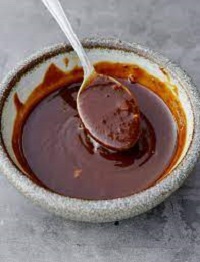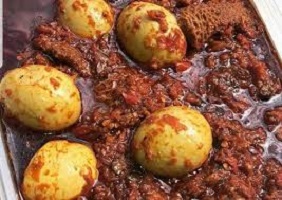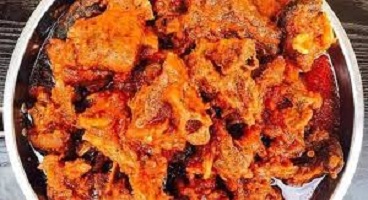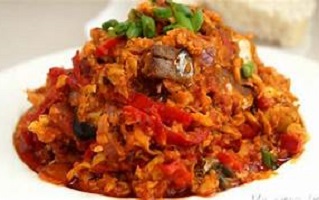Hoisin Sauce Recipe
Hoisin Sauce Recipe

Hoisin sauce is a fragrant, pungent Asian vegetable stir-fry sauce that’s also used in marinades and grilled dishes. It’s a common ingredient in many Chinese and Vietnamese dishes, and it’s also known as Chinese barbecue sauce.
What Is Hoisin Sauce? Hoisin Sauce What Is?
Hoisin sauce is a condiment made from fermented soybean paste and flavored with various spices and flavors. It gives dishes an Asian twist by combining umami with sweet, tangy, and spicy flavors.
It is gluten-free and vegan/vegetarian friendly because it is made without any animal products, though it is traditionally served with Peking duck, a Cantonese dish. If you’re avoiding soy, look for a soy-free version made with another bean.
Origin of Hoisin Sauce
Apart from the fact that it is Cantonese, little is known about the origins of hoisin sauce. Hoisin is derived from the Chinese word for seafood, and earlier versions may have included a seafood ingredient to add umami flavor. It no longer contains any seafood. Furthermore, it is rarely used with seafood, so the origin of the name is unknown.
What is in Hoisin Sauce?
Fermented soybean paste, garlic, vinegar, sesame oil, chiles, and sweetener are used to make hoisin sauce. Preservatives, stabilizers, and coloring agents may be added to commercially prepared hoisin sauce.
Sugar, water, fermented soybean paste (contains wheat flour), salt, sweet potato powder, modified cornstarch, sesame paste, garlic, chili peppers, and spices are among the ingredients in the popular Lee Kum Kee brand.
What Is the Taste of Hoisin Sauce?
Hoisin is a dark-colored sauce with a thick consistency. It has a strong salty and slightly sweet taste to it. Hoisin sauce resembles American-style barbecue sauce in flavor, but it’s much saltier, richer, and less sweet, with its own distinct flavor. The fermented soybeans provide the savory umami flavor that some other sauces achieve by using fish or meat.
Because the distinct flavor can be overpowering, especially if you’re new to Asian cuisine, it’s best to start small and experiment with the flavor. Or, before using it in a recipe, dilute the flavor by adding water or oil to the hoisin sauce.
Hoisin sauce is a great way to give a stir-fry or noodle dish an authentic Asian flavor, thickening, and color. It can also be used to dip egg rolls, spring rolls, or other appetizers.
Required Ingredients for Hoisin Sauce ~ Hoisin sauce ingredients
This recipe’s best feature is that all of the ingredients were already in my pantry! They collaborated to produce the most flavorful end product possible. You’ll adore it in your kitchen!
- Soy Sauce: Adding soy sauce to your hoisin will give it a salty boost. In my cooking, I like to use Kikkoman soy sauce! If you’re watching your sodium intake, use light soy sauce instead.
- Molasses: This will make your hoisin sauce thicker. Here, we want a perfect glaze-like texture.
- Sesame Oil: Sesame oil gives your hoisin sauce a distinct nutty flavor. It’s one of the most important ingredients in achieving a complex, rich flavor. My favorite brand is Ottogi!
- Rice Vinegar: This is where you get the tang. Rice vinegar adds just the right amount of sweetness and tanginess to the dish. In this recipe, I use Marukan rice vinegar.
- Peanut Butter: Who knew peanut butter could be so versatile? This is what gives your hoisin sauce its incredible thickness and umami flavor.
- Garlic: For a strong, savory flavor, I use finely minced garlic in this recipe.
- Sriracha Sauce: Sriracha adds just the right amount of heat. If you want a sauce with more heat, adjust to taste!
- Add ground pepper for a flavorful, earthy kick.
- Water: As needed to achieve the desired consistency.
- Cornstarch: This will thicken your sauce nicely.
Hoisin Sauce Recipe: How to Make Hoisin Sauce
Time to prepare: 5 minutes
Time to cook: 3 minutes
8-minute total time
- ¼ cup molasses
- 2 tablespoons + ½ teaspoon soy sauce
- 2 tablespoons creamy peanut butter
- ½ teaspoon garlic powder
- 2 tablespoons rice vinegar or white wine vinegar
- 1½ teaspoons cornstarch
- ½ teaspoon hot sauce (or Sriracha or chili paste)
Instructions
- Combine all ingredients (except cornstarch) in a small saucepan. Heat until the molasses and peanut butter have dissolved over medium heat.
- Combine the cornstarch and 1 1/2 teaspoon of cold water in a small bowl. Stir constantly until the cornstarch is completely dissolved.
- Raise the heat to medium-high in the saucepan and whisk in the cornstarch mixture. Cook for 1-2 minutes, or until the mixture thickens.
- Remove the sauce from the heat and set it aside to cool. Your Homemade Hoisin sauce is ready. (As the sauce cools, it will thicken even more.)
- Use the sauce right away to marinate meat, as a dip, or as a stir-fry sauce.
- Refrigerate any leftover sauce for up to two weeks. (The sauce will firm up in the refrigerator; before using, give it a good stir.)
* 1/2 cup Hoisin Sauce coats 1 pound of meat and roughly 1 pound of vegetables.
Nutrition
34kcal, 5.3g carbohydrate, 0.9g protein, 1g total fat, 0g unsaturated fat, 4353mg sodium, 22mg potassium, 3.1g sugar
Recipes with Hoisin Sauce
Hoisin sauce can be found in a wide range of recipes, from main courses to stir-fries to vegetable side dishes. Hoisin sauce is used in many Asian vegan and vegetarian recipes.
- Vegan Thai Stir-Fry
- Hoisin Spare Ribs
- Hoisin Ginger Sesame Pork Chops
- Hoisin-Glazed Salmon
- Tasty Grilled Hoisin Chicken
- Slow Cooker Hoisin Ribs
- Hoisin Chicken Stir-Fry
Hoisin sauce substitution
If you can’t find hoisin sauce in the store, try making a homemade version with peanut butter, miso, or black bean paste; you can also make a raw vegan version. If you don’t have hoisin sauce on hand, you can use Chinese brown bean sauce or chee hou sauce, which are both made from soybeans but may be spicier.
Another quick substitute is to mix sriracha and Chinese five spice powder into traditional American sweet barbecue sauce. Check any substitutes to see if they contain any of the foods you’re avoiding, such as animal products or gluten.
Where can I Buy Hoisin Sauce?
Hoisin sauce can be found in the Asian food section of most supermarkets; look for brands like Lee Kum Kee. Shopping at Chinese or Asian specialty grocers may help you find more authentic Asian producers. Hoisin sauce is also available for purchase online.
Storage
Unopened bottles of hoisin sauce can be kept in a cool, dark place for several years.
Check the “best by” date on the bottle to see when it will start to degrade. If you’ve had the sauce for a while, make sure it hasn’t developed any mold or an odor.
Once you’ve opened a bottle, keep it refrigerated. However, you don’t have to use it right away because the high salt content will keep bacteria and mold at bay for up to a year in the refrigerator. Mold, odor, or discoloration are all signs that it’s time to get rid of it.
Is Hoisin Sauce made with seafood?
Hoisin (pronounced HOY-szin) is a Chinese word that means “seafood.”
Despite its name, hoisin sauce contains no seafood and is not commonly served with seafood.
The origin of the sauce’s name is a mystery that no one seems to have solved.
What Is The Difference Between Hoisin And Soy Sauce?
Hoisin sauce has a thicker consistency and a sweeter flavor than soy sauce.
Our hoisin sauce contains soy sauce, but it also contains a variety of other ingredients that give it its distinct flavor.
Plum Sauce vs. Hoisin Sauce
While they have a similar flavor, hoisin sauce and plum sauce are not the same things.
Hoisin sauce is usually hotter and has stronger flavors, whereas plum sauce is more like a jam made from plums.
The good news is that their flavors are similar enough that they can be substituted for one another in a pinch.
Regional Cuisines with Hoisin Sauce
Cantonese Cuisine
In Cantonese cooking, hoisin sauce is used as a meat marinade or as a dipping sauce.
For meats like char siu, hoisin sauce can be used as a marinade.
Steamed or panfried rice noodle rolls (chángfn ) can be served with hoisin sauce as a dipping sauce.
America Cuisine
Peking duck and lettuce wraps can be served with hoisin sauce as a dipping sauce.
For moo shu pork, hoisin sauce can be used as a dipping sauce.
Vietnam Cuisine
Tng en is the Vietnamese word for hoisin sauce. In southern Vietnam, it is a popular condiment for ph, a Vietnamese noodle soup. The sauce can be poured directly into a bowl of pho at the table or used as a dip for meat in pho dishes. Hoisin sauce is usually served with Sriracha sauce or tng in ph. Hoisin sauce is also used as a dipping sauce for Vietnamese gi cun (also known as “spring rolls”) and other similar dishes. It can be used to glaze broiled chicken in the kitchen.
It’s pretty much an all-purpose condiment because it goes with so much.
Hoisin Sauce can be used in a variety of ways which are as follows:
- Serve with your favorite Chinese egg rolls or Vietnamese spring rolls as a dip.
- As a Peking duck and Chinese barbecue pork sauce
- Beef noodle soup is used as a condiment in Vietnamese Pho.
- In a beef stir fry as a sauce
- In stir-fries and noodle dishes
- Slathered on baked or grilled chicken, pork, ribs, duck, or tofu
- Mixed in with vegetables
- Use it in marinades, vinaigrettes, and barbecue sauces.
- An all-purpose ketchup substitute
- A new meatloaf recipe
- Spread on burgers
- To make pulled pork or chicken
- The great flavor when added to soup broths
- The sauce that goes on Chinese pizzas.
- A Chinese twist on mayonnaise
- Use as a dipping sauce for Chinese dumplings, egg rolls, wontons, and chicken nuggets, among other things.
What are the signs That Your Hoisin Sauce Has Gone Bad?
Mold is the first thing to look for. The presence of mold indicates that your hoisin sauce has gone bad and that you should discard it. Sniffing the sauce can also help you determine its condition. If it smells sour or fermented in any way, it’s best to throw it out.
Dehydration is the third thing to look for. If the hoisin sauce is hard or rubbery, it has lost a lot of moisture and won’t have the flavor profile or consistency you want.
If this occurs, you should discard the jar rather than attempt to use it.
How Do You Avoid Your Hoisin Sauce Going Bad?
You should keep your jar of hoisin sauce refrigerated as soon as possible after opening it (or making it from scratch). Do not break the vacuum seal on the jar if refrigeration is not an option and you want to extend the shelf life of your hoisin sauce. The countdown to it going bad starts the moment you break the seal.
Frequently Asked Questions on Hoisin Sauce
What is The Most Similar Sauce to Hoisin Sauce?
Soy sauce and tamari sauce can also be used to season vegetables and stir-fry dishes.
Barbecue sauce is an excellent meat substitute. For dipping, use duck or orange sauce.
Is there a difference between hoisin and oyster sauce? Hoisin vs. oyster sauce
Oyster Sauce has a higher salt content than Hoisin Sauce. Fresher and sweeter, oyster sauce smells. Hoisin Sauce has a fishy, oceanic aroma. Nutrition: Oyster sauce contains sugar and contains less salt than Hoisin Sauce.
Is hoisin sauce extremely hot (Spicy)?
Hoisin sauce, also known as Peking sauce, is a thick reddish-brown sauce that is used in Chinese cuisine as a cooking ingredient as well as a table condiment. It’s sweet and spicy, made with soybeans, flour, sugar, water, spices, garlic, and chili.
Is it necessary to keep hoisin sauce refrigerated?
How do you avoid your hoisin sauce going bad?
You should keep your jar of hoisin sauce refrigerated as soon as possible after opening it (or making it from scratch). Do not break the vacuum seal on the jar if refrigeration is not an option and you want to extend the shelf life of your hoisin sauce.
When Hoisin Sauce is opened, how long does it last?
Hoisin sauce that has been kept refrigerated for a long time will keep its best quality for 12 to 18 months.
Is It Safe To Eat Hoisin Sauce?
These freshness estimates, on the other hand, are only suggestions; they only address the sauce’s intensity, texture, flavor, and color, not its safety.
While the taste and color of refrigerated hoisin sauce may fade or change over time, it is safe to eat for an indefinite period of time.
Why is there so much sugar in hoisin sauce?
While hoisin sauce is virtually fat-free, it does contain a significant amount of sugar. After water, sugar is listed as the second ingredient on the Dynasty brand food label. Sugar is the primary ingredient in hoisin sauce, which is listed in order of decreasing weight.
Is hoisin sauce a keto-friendly condiment?
Because it is a high-carb processed food with unhealthy ingredients like sugar and modified starch, hoisin sauce is not keto-friendly.


